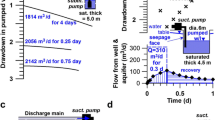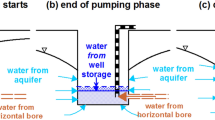Abstract
For unconsolidated aquifers of limited saturated thickness and adequate permeability, inverted wells can provide the discharge required for public water supply, industry or extensive irrigation. In an inverted well, the housing (casing) extends to the base of the aquifer with up to four screens projecting upwards; the pump can be located toward the bottom of the housing. Inverted wells have proved to be successful in the older alluvial deposits in the north-west of Bangladesh. Field measurements at a pumping site, where a conventional well was replaced by an inverted well, demonstrate how an inverted well provides a substantial discharge in an aquifer of sand zones even when the saturated thickness becomes less than 20 m. Measurements of groundwater heads at the water table and deeper within the aquifer system lead to a conceptual understanding of the flow processes associated with an inverted well. Since the pumping water level in the housing can be below the top of the screens, an investigation into conditions in the gravel pack indicate that there is a column of water in the gravel pack which is higher than the pumped water level. Comparisons are made between conventional and inverted wells. Although an inverted well costs more than a conventional well, its ability to provide a reliable discharge from an aquifer of limited saturated thickness is a significant advantage.
Résumé
Dans des aquifères meubles d’épaisseur saturée réduite et de perméabilité suffisante, des puits inverses peuvent fournir le débit requis pour l’alimentation en eau publique, l’industrie ou l’agriculture extensive. Dans un puits inverse, le tubage descend jusqu’à la base de l’aquifère, avec jusqu’à quatre crépines étagées; la pompe peut être mise en place à la base du tubage. Les puits inverses ont montré qu’ils étaient efficaces dans les dépôts alluviaux plus anciens du Nord-Ouest du Bengladesh. Les mesures de terrain effectuées sur un site de pompage dans lequel un puits classique a été remplacé par un puits inverse, démontrent comment un puits inverse fournit un débit substantiel dans un aquifère à passées sableuses même quand l’épaisseur saturée devient inférieure à 20 m. Les mesures de la charge des eaux souterraines à la surface de la nappe et plus profondément à l’intérieur du système aquifère, conduisent à une compréhension conceptuelle des processus d’écoulement associés à un puits inverse. Etant donné que le niveau de l’eau dans le tubage peut se situer en pompage au-dessous du sommet des crépines, un examen de l’état du massif filtrant indique qu’il y a une colonne d’eau dans le massif de gravier au-dessus du niveau de l’eau pompée. Des comparaisons sont faites entre puits classiques et puits inverses. Bien qu’un puits inverse coûte plus cher qu’un puits classique, sa capacité à fournir un débit fiable à partir d’un aquifère d’épaisseur saturée réduite est un avantage considérable.
Resumen
En el caso de acuíferos no consolidados de reducido espesor saturado y suficiente permeabilidad, los pozos invertidos pueden proporcionar la descarga necesaria para el abastecimiento público de agua, la industria o el riego extensivo. En un pozo invertido, la estructura (revestimiento) se extiende hasta la base del acuífero con hasta cuatro pantallas que se proyectan hacia arriba; la bomba puede situarse hacia el fondo de la estructura. Los pozos invertidos han demostrado su eficacia en los depósitos aluviales más antiguos del noroeste de Bangladesh. Las mediciones sobre el terreno en un emplazamiento de bombeo, en el que se sustituyó un pozo convencional por un pozo invertido, demuestran cómo este último proporciona una descarga sustancial en un acuífero de zonas arenosas incluso cuando el espesor saturado es inferior a 20 m. Las mediciones de las alturas de las aguas subterráneas en el nivel freático y en las profundidades del sistema acuífero permiten comprender conceptualmente los procesos de flujo asociados a un pozo invertido. Dado que el nivel de agua de bombeo en el pozo puede estar por debajo de la parte superior de las rejillas, una investigación de las condiciones en el paquete de grava indica que hay una columna de agua en el paquete de grava que es más alta que el nivel de agua bombeada. Se comparan los pozos convencionales y los invertidos. Aunque un pozo de este tipo es más caro que uno convencional, su capacidad para proporcionar una descarga fiable de un acuífero de reducido espesor saturado es una ventaja significativa.
摘要
对于饱和厚度有限且渗透性强的松散含水层,反渗井可以提供公共供水、工业或大面积灌溉所需的用水。在反渗井中,井的外壳 (套管)延伸至含水层底部,向上突出的滤管多达四个;水泵可以位于井的外壳底部。事实证明,在孟加拉国西北部较老的冲积矿床中,反渗井的使用是成功的。在抽水站进行的野外测量表明,即使在含水层饱和厚度小于20 m的情况下,用反渗井代替常规井,能够在砂质含水层中排放大量的水。对地下水位和含水层系统更深处的地下水头进行测量,可以从概念上理解与反渗井相关的流动过程。由于水泵的抽水水位可能低于滤管顶部,对砾石充填状况的调查表明,在砾石充填中存在高于抽水水位的水柱。在常规井和反渗井之间进行了比较,尽管反渗井的成本高于常规井,但它在有限饱和厚度的含水层中提供可靠的排放能力是一个显著的优势。
Resumo
Para aquíferos não consolidados de espessura saturada limitada e permeabilidade adequada, poços invertidos podem fornecer a descarga necessária para o fornecimento público de água, industrial ou irrigação extensiva. Em um poço invertido, o revestimento se estende para a base do aquífero com até quatro telas projetadas para cima; a bomba pode ser colocada em direção ao fundo da vedação. Poços invertidos se provaram ser bem-sucedidos em depósitos aluviais antigos no noroeste de Bangladesh. Medidas de campo em um local de bombeamento, onde um poço convencional foi trocado por um poço invertido, demonstraram como um poço invertido fornece uma descarga substancial em um aquífero de zonas arenosas mesmo quando a espessura de saturação se torna menor que 20 metros. Medidas de cargas hidráulicas de águas subterrâneas no nível freático e em nível mais profundo no sistema aquífero levam a um entendimento conceitual dos processos de fluxo associados com um poço invertido. Uma vez que o nível de água bombeada na vedação pode ser abaixo do topo das telas, uma investigação das condições no pacote de cascalho indica que há uma coluna de água no pacote de cascalho que é maior do que o nível de água bombeada. Comparações são feitas entre poços convencionais e invertidos. Embora um poço invertido custe mais que um poço convencional, a sua capacidade de fornecer uma descarga confiável de um aquífero de espessura de saturação limitada é uma vantagem significante.






Similar content being viewed by others
References
Foster SSD, Chilton PJ (2003) Groundwater: the processes and global significance of aquifer degradation. Philos Trans R Soc B 358(1440):1957–1972. https://doi.org/10.1098/rstb.2003.1380
Gailey RM, Lund JR, Azuara JM (2019) Domestic well reliability: evaluating supply interruptions from groundwater overdraft, estimating costs and managing economic externalities. Hydrogeol J 27(4):1159–1182. https://doi.org/10.1007/s10040-019-01929-w
Harlan RL, Kolm KE, Gutentag ED (1989) Water well design and construction. Elsevier, Amsterdam, 205 pp
Hasan MAFMR, Keramat MM, Shahid S, Yasmin R, Mohsenipour M, Sattar GS (2016) Evaluation of subsurface lithologic units for groundwater exploration in the Barind Tract of Bangladesh. Geotech Geol Eng 34:1395–1411. https://doi.org/10.1007/s10706-016-0050-6
Hossain MI, Bari N, Matin (2020) Groundwater zoning for the north-west region of Bangladesh. Hydrology 8(3):52–61. https://doi.org/10.11648/j.hyd.20200803.13
Misstear BDR, Banks D, Clark L (2017) Water wells and boreholes, 2nd edn. Wiley-Blackwell, Chichester, UK
Mojid MA, Parvez MF, Mainuddin M, Hodgson G (2019) Water table trend: a sustainability status of groundwater development in north-west Bangladesh. Water 11(6):1182. https://doi.org/10.3390/w11061182
Rashid MA, Hossain MI (2019) Irrigation management system of BMDA: an innovative approach. Conference: 2nd International Conference on Planning, Architecture and Civil Engineering (ICPACE), Faculty of Civil Engineering, RUET, Rajshahi, Bangladesh
Rushton KR, Howard KWF (1982) The unreliability of open observation boreholes in unconfined aquifer pumping tests. Ground Water 20:546–550
Rushton KR, Asaduz Zaman M (2017) Development of unconfined conditions in multi-aquifer flow systems: a case study in the Rajshahi Barind, Bangladesh. Hydrogeol J 25:25–38. https://doi.org/10.1007/s10040-016-1463-2
Rushton KR, Zaman MA, Hasan M (2020) Monitoring groundwater heads and estimating recharge in multi-aquifer systems illustrated by an irrigated area in north-west Bangladesh. Sustain Water Resour Manag 6, article 22. https://doi.org/10.1007/s40899-020-00382-y
Sterret RJ (ed) (2007) Groundwater and wells, 3rd edn. Johnsons Screens, New Brighton, MN
UNDP (1982) Ground water survey: the hydrogeological conditions of Bangladesh. Technical report DP/UN/BGD-74-0071, United Nations Development Programme, New York
Zaman MA (2009) Innovation of inverted well changes the concept of conventional well design. Thirteenth International Water Technology Conference, Hurghada, Egypt, March 2009, pp 1363–1371
Zaman MA, Rushton KR (2006) Improved yield from aquifers of limited saturated thickness using inverted wells. J Hydrol 326:311–324
Acknowledgements
The development of inverted wells was carried out by the Barind Multipurpose Development Authority. Also, the authors acknowledge the valuable and enthusiastic assistance of Mr. Mehedi Hasan, Dr. Nurul Islam, Mr. Samsher Ali, Mr. Shah Monjurul Hasan and Mr. Zahid Hossain Reza with the fieldwork.
Author information
Authors and Affiliations
Corresponding author
Ethics declarations
Conflict of interest
There are no conflict of interest issues.
Additional information
Publisher’s note
Springer Nature remains neutral with regard to jurisdictional claims in published maps and institutional affiliations.
Rights and permissions
Springer Nature or its licensor holds exclusive rights to this article under a publishing agreement with the author(s) or other rightsholder(s); author self-archiving of the accepted manuscript version of this article is solely governed by the terms of such publishing agreement and applicable law.
About this article
Cite this article
Rushton, K.R., Zaman, M.A. Inverted wells in unconsolidated aquifers of limited saturated thickness. Hydrogeol J 30, 2163–2169 (2022). https://doi.org/10.1007/s10040-022-02532-2
Received:
Accepted:
Published:
Issue Date:
DOI: https://doi.org/10.1007/s10040-022-02532-2




